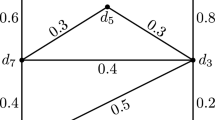Abstract
Communication networks have been characterized by high levels of service reliability. Links cuts, node interruptions, software errors or hardware failures, and transmission failures at various points can interrupt service for long periods of time. In communication networks, greater degrees of stability or less vulnerability is required. The vulnerability of communication network measures the resistance of the network to the disruption of operation after the failure of certain stations or communication links. If we think of a graph G as modeling a network, many graph-theoretic parameters can be used to describe the stability of communication networks, including connectivity, integrity, and tenacity. We consider two graphs with the same connectivity, but with unequal orders of theirs largest components. Then these two graphs must be different in respect to stability. How can we measure that property? The idea behind the answer is the concept of integrity, which is different from connectivity. Total graphs constitute a large class of graphs. In this paper, we study the integrity of total graphs via some graph parameters.
Similar content being viewed by others
REFERENCES
V. Kumar, A Grama, A. Gupta,and G. Karpis, Introduction to Parallel Computing The Benjamin Cummings Publ., California, 1995.
L. Lesniak and G. Chartrand,Graphs and Digraphs Wadsworth & Brooks, California, 1986.
M.B. Cozzens and S.Y. Wu,“Edge neighbor-integrity of trees,”Austral. J. Combin.,10 (1994), 163–174.
M.B. Cozzens and S.Y. Yu,“Vertex neighbor-integrity of trees,”Ars. Combin.,43 (1996), 169–180.
V. Chvatal,“Tough graphs and Hamiltonian circuits,”Discrete Math.,5 (1973), 215–218.
P. Dündar, “The tenacity of hypercube graphs and its some compounds,” Neural Networks World 3/99 (1999), 225–234.
P. Dündar, “Stability measures of some static interconnection networks,” Intern. J. Comput. Math., 76 (2001), no.4, 455–462.
P. Dündar, “Accessibility numbe and the neighbour-integrity of generalized Petersen graphs,” Neural Network World 2 (2001), 167–174.
P. Dündar and A. Ozan, “Stability measures of torus and mesh graphs,” Intern. J. Math. Algorithms (2002 (submitted)).
P. Dündar and A. Ozan, “The neighbour-integrity of sequential joined graphs,” Intern. J. Comput. Math., 74 (2000), 45–52.
P. Dündar, “The neighbour-integrity of Boolean graphs and its compounds,” Intern. J. Comput. Math., 72 (1999), 441–447.
P. Dündar, “New notions in network reliability:stability numbers of sequential joined graphs,” Neural Network World 5 (1999), 403–411.
P. Dündar, “The stability measures of static interconnection networks and binary trees,” in:Proceeding of the Third International Symposium on Computer Networks İzmir,1998, pp.240–245.
P. Dündar and O. Ten,“A new parameter for network stability: the neighbour-tenacity,” in:Proceedings of the 14th Intern. Symposium on Comput. and Information Sciences, Kusadasi,1999, pp.1016–1018.
P. Dündar and N. Ö ürk, “The neighbour-integrity of recursive graphs,” in:Proceedings of the 2nd Intern. Symposium on Math. and Computational Applications, Baku,1999, pp.443–447.
K.S. Bagga and L.W. Beineke, “Survey of integrity,” Discrete Appl. Math., 37/38 (1992), 13–28.
C.A. Barefoot and R. Entringer, “Vulnerability in graphs —a comparative survey,” J. Combin. Math. Combin. (1989), 113–122.
L.W. Beinike, W. Goddard, P. Hamburger,and D.J. Kleitman, M.J. Lipman,and R.E. Pippert, “The integrity of the cube is small,” J. Combin. Math. Combin. Comput., 9 (1991), 191–193.
W. Goddard and H.C. Swart, “Integrity in graphs:bounds and basics,” J. Combin. Math. Combin. Comput., 7 (1990), 139–151.
K.S. Bagga, L.W. Beineke, M.J. Lipman,and R.E. Pippert, “Edge-integrity:a survey,” Discrete Math., 124 (1994), 3–12.
K.S. Bagga, L.W. Beineke, M.J. Lipman, and R.E. Pippert, “On the edge-integrity of graphs,” Congres. Numer., 60 (1987), 141–144.
K.S. Bagga, L.W. Beineke, M.J. Lipman, and R.E. Pippert,and R.L. Sedlmeyer, “A good algorithm for the computation of the edge-integrity of trees,” Congres. Numer., 67 (1988), 225–232.
F. Harary, Graph Theory Addison-Wesley Publ., California, 1971.
Author information
Authors and Affiliations
Rights and permissions
About this article
Cite this article
Dündar, P., Aytaç, A. Integrity of Total Graphs via Certain Parameters. Mathematical Notes 76, 665–672 (2004). https://doi.org/10.1023/B:MATN.0000049665.92885.26
Issue Date:
DOI: https://doi.org/10.1023/B:MATN.0000049665.92885.26




